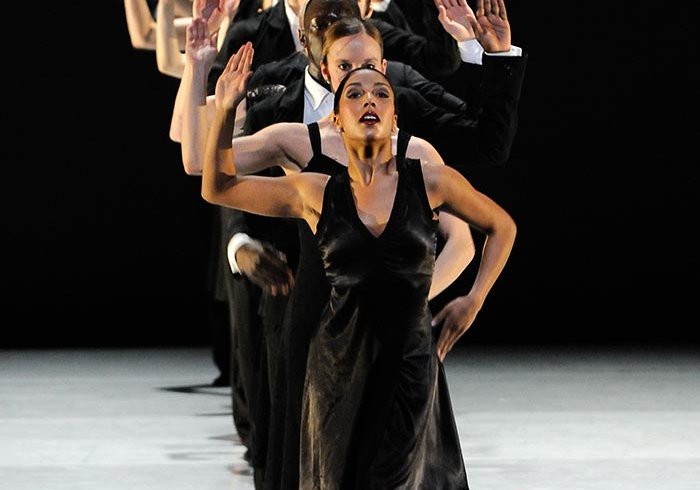In Motion premiered three years ago at Vancouver’s Queen Elizabeth Theatre. The ensemble stood out as a highlight of artistic director Emily Molnar’s impressive second season at Ballet BC. In it, two muscular men, Dario Dinuzzi and Gilbert Small, powered through a twisting, turning duet. One minute, the weight of their bodies took them to the ground, and the next they were assisting each other in airborne manoeuvres, hoisting a partner’s leg or offering a back for support. Their closely connected dance was gymnastic, yes, but also erotic, with its complex play of effort and abandon as they tumbled and fell to the sound of a violin. This was not your old-fashioned, ethereal pas de deux, in which the man’s primary function is to make the woman shine. The same-sex duet went further in the equality of force and motion between dancers than most contemporary heterosexual ones.
The company remounted In Motion this February, and the choreographer, Wen Wei Wang, makes a smart match for Ballet BC’s characteristically friendly aesthetic. Well known to Vancouver audiences for his modern work with Wen Wei Dance, he understands how to use Ballet BC’s technical prowess; he spent several years dancing with the company early on in his career. As well, his Chinese training brings a welcome Asian influence to the stage: grounded lunges and organic upper-body flow inspired by martial arts and tai chi subvert the formality of ballet, making it feel fresh and accessible.
When Molnar took over in July 2009, Ballet BC’s prospects were poor: it had recently gone through bankruptcy proceedings, and the large theatre had become increasingly difficult to fill. The story ballets from then artistic director John Alleyne, with their complicated narratives, failed to engage local audiences; and a sudden addition of American repertoire (Twyla Tharp’s middle-of-the-road Nine Sinatra Songs and, right out of left field, Martha Graham’s modern dance classic Appalachian Spring) seemed like a desperate attempt to broaden the company’s appeal.
Five years later, Molnar has accomplished what once seemed impossible. A happy buzz at intermission is now the norm, and the theatre is full of bustling crowds—thanks in part to a canny move by the Molnar regime, restricting ticket sales to the orchestra and mezzanine levels, to prevent the once-common sight of empty seats sprinkled throughout the auditorium. In the meantime, her grand ambition has emerged: to challenge the homogeneity and hierarchy of classical ballet.
Ballet BC’s dancers attract high praise from audiences and critics alike. They present as real men and women who inhabit our world, rather than thoroughbreds cut from the same elite, anachronistic mould. The women, for one thing, are not uniformly tiny. Some ethnic diversity within the company at least begins to reflect Vancouver’s rich multiculturalism, although the trend could still go further, as it could across the profession. Even the most prestigious organizations are finally beginning to recognize this: At the Paris Opera Ballet, the birthplace of classical ballet, incoming director Benjamin Millepied publicly complained in 2013 that the company had too few “dancers of colour.” Meanwhile, the American Ballet Theatre has launched Project Plié, a national program designed to support students from “diverse backgrounds,” and to help “increase racial and ethnic representation” in US companies.
Different body types and skin colours were part of the old Ballet BC, too. Under Molnar, however, the artists bring more than unique physical attributes to the stage: she wants to make a feature of individual personalities. This, within the context of a lively repertoire, seems to lie at the root of the company’s present popularity. Each performer, rather than a few stars in the group, is encouraged to be unique. “Dancers,” she asserts, “have to have a sense of self.”
To understand how revolutionary this belief is in the ballet world, you must remember that the art form was born in the French court, and echoes of that rigid, hierarchical society linger. Dancers are trained from a young age to show obedience and respect for authority; classes typically end with a curtsy or a bow; then there is the old habit of calling dancers—whatever their age—boys and girls. Most companies still rank their performers into principals, soloists, and corps de ballet. Even in groups that eschew this star system, a hierarchy remains, with artistic directors and choreographers at the top and dancers at the bottom.
In the November/December 2013 issue of The Dance Current, Bryna Pascoe, one of several dancers who left Les Grands Ballets Canadiens de Montréal last year, revealed her frustration at how management was treating her and her colleagues “as though we’re in school, as though we’re not full adults.” Last spring, this attitude contributed to a labour relations crisis that ended with the dancers joining Equity, the performing artists’ union.
In October 2013, I arrived for an interview with Molnar in her sixth-floor office at the Scotiabank Dance Centre, an Arthur Erickson–designed hub in Vancouver’s downtown. The five-foot-eleven forty-year-old immediately moved out from behind her desk to sit closer, clearly wanting a friendlier set-up for our exchange.
Born in Regina, Molnar was a member of the National Ballet of Canada for just a few years before heading off to Germany at twenty-one to join William Forsythe’s company. A great innovator, celebrated for his edgy, avant-garde aesthetic, Forsythe established one of the first egalitarian companies at Frankfurt Ballet. “You had to be very independent and take your own initiative,” Molnar recalls. Of his experience there, British choreographer David Dawson remarked last October in the Financial Times, “One thing [Forsythe] taught me is how to be an adult in dance. He treats everybody that way and it was new to me, very different from the hierarchy that I’d found elsewhere.”
Molnar left the company in 1998, keen to develop her own voice. That same year, she returned to Canada feeling a little burned out, unsure of how and where to make her mark; she thought about studying anthropology. Instead, she joined Ballet BC as a principal dancer. Artistic director John Alleyne was a friend from her National Ballet School days, where she had performed his neo-classically based choreography. At Ballet BC, starring in his productions—as a commanding Puck in The Faerie Queen and as the title character in Scheherazade—she became well known as his muse. While that role is seldom thought of as equal or active, Molnar insists that she was never mere mouldable clay: “My relationship with choreographers like John, like Billy Forsythe, was that I participated in building vocabulary.”
In 2003, she struck out on her own as an independent choreographer, struggling to shake off Forsythe’s cerebral approach, as have so many others who have worked with him. Iconic Canadian soloist Margie Gillis, who dances from a deeply emotional inspiration, mentored her. Over the next few years, Molnar’s choreography was commissioned by companies in Calgary, New York, and Mannheim, Germany. She continued directing a student group at Vancouver’s Arts Umbrella and, when she had a moment alone in the studio, wrestled with how best to coach dancers and nurture talent, “because you can bear all of the basic gifts, but without other things like incredibly hard work, curiosity, courage to take risks, the intelligence to think further than what you’ve just been given…” Her voice trails off, but the implications are clear.
She quickly established herself as a quirky, warm-hearted contemporary choreographer, receiving high-profile attention from the Guardian for Six Fold Illuminate (with Christopher Wheeldon’s Morphoses company) in September 2008. Less than a year later, Ballet BC was without an artistic director, having terminated Alleyne’s contract as the company struggled to rebuild after narrowly averting bankruptcy. Molnar had to go after the job.
“Ever since I was a kid, I knew I wanted to direct,” she says. Vancouver DanceHouse producer Jim Smith recalls having coffee with her while she was still working independently, and they discussed how she might develop the skills to lead an organization. “It heartened me,” Smith says, “because most artists just want to make their work. Few want to be leaders. Emily was looking for a broader canvas.”
One of her first moves as director was to organize a meeting with her troupe. Instead of using the studio—where dancers sprawl on the floor in tights and leotards while the director or choreographer (the adult, the one in charge) sits above them on a chair—she booked the boardroom, where everyone would have a seat, dressed in street clothes.
From the outset, she made it clear that she wanted an egalitarian atmosphere, free of the bullying that can occur in an unequal situation. “I told them, ‘I’m not going to be the kind of director who tells you what you’re not so you can prove to me what you are.’” To encourage the artists to take ownership of their work, she asked them to sign a mission statement, which contained the usual sloganeering about being “a leader and [an] innovator of world-class dance,” but also defined the company as “an interactive community.”
Amid the new regimen of independence and hard work, with an extra half-hour tacked on to the workday, some turnover has occurred, but there is no obvious discontent. It helps that several of the eighteen dancers trained at Arts Umbrella, a natural feeder school for Molnar; artistic director Artemis Gordon also champions what could be called the “thinking dancer.” The catchphrase is common in modern dance, which tends to be more forgiving in terms of technique, allowing time to engage students intellectually. Molnar wants both: virtuosic technique and curious, questing thinkers.
The goal, she says, is to cultivate artists, not dancer-technicians, who will take responsibility for the cycle of new creation at the centre of Ballet BC; seven premieres were commissioned for this season alone. Last fall, I caught a glimpse behind the scenes when I attended a rehearsal with Finland’s Jorma Elo, a leading choreographer who specializes in the lively aesthetic that Molnar favours, and whom she had snagged for a commission. The studio was filled with couples and small groups, quietly and intensely testing and refining their movements. No one waited to be prodded or looked bored and disengaged. Elo rushed here and there, talking little, moving a lot, bobbing happily in the stream of self-motivated artists.
“We’re often seen as the baby of the art forms,” observes Molnar, keen to position ballet as more than “just an entertainment” rather a fully grown “critical art.” To do this, she searches out dancers with contemporary voices, from Europe, the US, and closer to home, as with Wang.
Although In Motion carries a modern cultural subtext with its Asian-influenced moves and intimate same-sex duet, the piece is surprisingly conservative in one important way: Wang put all of the women in pointe shoes. Since their introduction in the romantic era, the shoes have been a lasting feature of women in ballet, creating a male-female divide that can look predictable and dated onstage.
Not every choreographer at Ballet BC uses them; Elo’s piece was performed in soft shoes. Molnar, who incorporated pointe shoes in her recent 16 + a room, argues for their contemporary relevance as a technical tool that enhances speed and extends the leg. “You can do things in pointe shoes you can’t do in runners or soft shoes or bare feet,” she says.
Why not put men on pointe to make things equal? Montreal’s Édouard Lock had Billy Smith on pointe in his über-cool 2002 production, Amelia. Molnar argues in favour of training different physiques for different tasks. “The men do a lot of grand allegro, and a lot of jumps and lifting—not to say that’s what they have to do,” she concedes. Pointe shoes are a matter of choice.
Building a substantial audience, one that will reliably fill the Queen Elizabeth Theatre from top to bottom, may well depend on how far Molnar and her choreographers can propel their works into the twenty-first century so they resonate with younger audiences. Her push for equality and individuality could make a lasting contribution to the maturing of the art form—the ethical rationale for running an egalitarian company is obvious, and the engaging performances offer a convincing aesthetic one—but Molnar could go further still. Imagine a company where in some ballets a few men of the right body type dance on pointe, and in others only some of the women do. Ballet would be one step closer to reflecting the fluidity and diversity that characterize modern life.
This appeared in the March 2014 issue.




